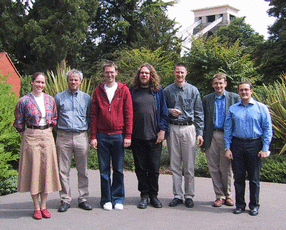by Martin Homer, University of Bristol, UK
The Bristol Centre for
Applied Nonlinear Mathematics (BCANM) at the University of Bristol has a unique
and proven track record for collaborative research between
mathematicians, engineers and applied scientists. It benefits from
its position in the Department of
Engineering Mathematics within the internationally renowned
Faculty of Engineering,
and was recently part of the successful JIF bid for £15M to fund the
Bristol Laboratory for Advanced
Dynamic Engineering (BLADE), Europe's most advanced dynamics
engineering facilities, due for completion in February 2004.
BCANM is supported by a £1.1M grant from the
Engineering and Physical Sciences
Research Council, the UK Government's funding agency for research
and training in engineering and the physical sciences. It is one of
the largest mathematics projects ever funded in the UK.
The mission of BCANM is to address both the mathematical themes of
the BLADE, and the grand engineering challenge of real-time dynamic
substructuring. Building on the internationally leading
interdiscipinary base of the Applied Nonlinear Mathematics group,
founded in 1992 by Prof. John Hogan, the members of BCANM will address
these aims with five postdoctoral research assistants, appointed on a
rolling programme over five years, to work on specific projects within
each theme, and a series of workshops and extensive visitor programme
centered on the themes. The mathematical themes the programme will
address are:
- Dynamical systems with delays
- Dynamics of piecewise smooth systems
- Qualitative numerical analysis of high-dimensional nonlinear systems
- Modelling spatially extended systems; continuous vs discrete
In addition, the permanent academic members of BCANM have a wide
range of research interests, including analysis and control of
piecewise smooth systems, analysis of local and global bifurcations,
numerical continuation of global bifurcations and solitary waves,
computation of invariant manifolds, control and synchronisation of
chaotic systems, nonlinear dynamics of laser systems, liquid crystal
dynamics, electrical control of porous media flows, non-integrable
nonlinear optics, localised elastic buckling in long structures,
nonlinear dynamics of power electronics systems and fractal analysis
of medical images.
There are currently 7 full time staff
members in the group headed by Prof. John Hogan, with 8 research
assistants and 12 postgraduates. esearch assistants and visitors are
housed in one large open-plan office, which has become a natural focus
for the BCANM's activities. There is significant synergy within the
group between staff, students and visitors, with an extensive series
of group activities e.g. several 1 or 2 day mini-meetings throughout
the year centering on individual methods or approaches or visiting
researchers, weekly formal seminars, bi-weekly informal seminars,
weekly working seminars and daily research coffee meetings. BCANM has
strong links, both internally within the Faculty of Engineering, the
Department of Mathematics and the Department of Physics, as well as
locally with the Centre for Nonlinear Mechanics at the University of
Bath, and with many research groups all over the world. One of the
main contacts of BCANM is with the €2M, 13 groups, 7 nations EU
project
SICONOS
(Modelling, Simulation and Control of Nonsmooth Dynamical Systems). In
addition, BCANM members have many active contacts with industry,
involving companies such as Westland, Jaguar, QinetiQ and British
Oxygen.

Photo taken
at the Colston meeting, June 2001.
From left to right: Hinke Osinga,
John Hogan, Martin Homer, Eddie Wilson, Bernd Krauskopf, Alan
Champneys, and Mario di
Bernardo.
A crucial part of the multidisciplinary research of BCANM is a
programme that allows us to attract the world's leading experts for
research visits on a continuous rolling programme. Visitors will be
able to conduct collaborative research towards each theme's
objectives, and make full use of the world-class facilities of
BLADE. Follow-up visits are also encouraged, to continue
collaboration. Each visitor will be encouraged to visit other UK
institutions, and also to present a set of tutorial lectures, which
will take place at Bristol, but be advertised nationally.
 The members of BCANM have organised many successful
conferences; the first of five workshops of the BCANM took place in
September 2003, on Delay Equations
and their Applications, stimulating interaction between
practitioners and theoreticians of all levels. The meeting opened
with tutorial presentations from Jack Hale (Georgia Institute of
Technology, USA) and Gábor Stépán (Technical
University of Budapest, Hungary). These lectures were video taped and
will appear shortly on the web. BCANM members were involved with the
organisation of the European study group with industry, held at
University of Bristol in April 2003. In June 2001 the ANM group hosted
the highly successful meeting Nonlinear
Dynamics and Chaos: Where do we go from here?, sponsored by the
EPSRC, LMS and Colston Research Society. The spirit of the meeting was
captured in the book Nonlinear
Dynamics and Chaos: where do we go from here? jointly edited by
all the permanent members of BCANM, published by IoP Publishing.
The members of BCANM have organised many successful
conferences; the first of five workshops of the BCANM took place in
September 2003, on Delay Equations
and their Applications, stimulating interaction between
practitioners and theoreticians of all levels. The meeting opened
with tutorial presentations from Jack Hale (Georgia Institute of
Technology, USA) and Gábor Stépán (Technical
University of Budapest, Hungary). These lectures were video taped and
will appear shortly on the web. BCANM members were involved with the
organisation of the European study group with industry, held at
University of Bristol in April 2003. In June 2001 the ANM group hosted
the highly successful meeting Nonlinear
Dynamics and Chaos: Where do we go from here?, sponsored by the
EPSRC, LMS and Colston Research Society. The spirit of the meeting was
captured in the book Nonlinear
Dynamics and Chaos: where do we go from here? jointly edited by
all the permanent members of BCANM, published by IoP Publishing.